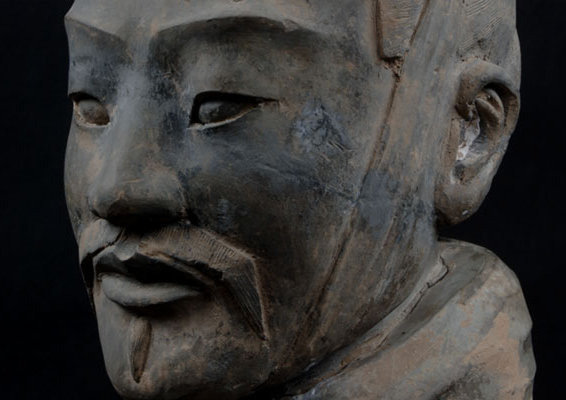The first emperor
dal 1/12/2010 al 12/3/2011
Segnalato da
1/12/2010
The first emperor
Art Gallery of New South Wales, Sydney
The first emperor: China's entombed warriors brings to Sydney one of the greatest archaeological discoveries of our time. This exhibition presents over 120 objects, 10 of the world-renowned warriors and horses, and significant recent finds from the First Emperor's mausoleum located in the province of Xi'an, central China. Through a display that evokes the actual pits of the entombed warriors, visitors are given an unprecedented opportunity to examine up close the intricacies of these wondrous life-size figures. The final section of the exhibition adds to the evolving story with a number of recently discovered objects.

The First Emperor: China’s entombed warriors brings to Sydney
one of the greatest archaeological discoveries of our time.
Australia was the first country outside China to see these figures
in the exhibition Qin Shihuang: Terracotta warriors and horses in
Sydney in early 1983. It is therefore fitting that the Art Gallery of
New South Wales should organise their return in an exhibition
presenting over 120 objects, with 10 of the world-renowned
warriors and horses, and significant recent finds from the
First Emperor’s mausoleum located in the province of Xi’an,
central China.
This exhibition explores the period of Chinese history preceding
the Qin dynasty of the First Emperor, and then establishes his
considerable achievements. Through a display that evokes the
actual pits of the entombed warriors, visitors are given an
unprecedented opportunity to examine up close the intricacies
of these wondrous life-size figures. The final section of the
exhibition adds to the evolving story with a number of recently
discovered objects.
The First Emperor: China’s entombed warriors is curated by the
Gallery’s director, Edmund Capon, a renowned authority on
Chinese art and archaeology, and Dr Liu Yang, senior curator of
Chinese Art. Edmund Capon was one of the first westerners to
see the initial find in 1974. The exhibition is designed by Richard
Johnson, architect of the Gallery’s superb Asian gallery and its
acclaimed exhibitions The arts of Islam (2007) and The lost
Buddhas (2008).
The exhibition is drawn from institutions including the Museum
of Terracotta Warriors and Horses, the Shaanxi Provincial
Archaeological Institute and the Shaanxi History Museum.
There is no other individual who has so impressed himself
on the unfolding drama of the history of the Middle Kingdom.
From the moment Qin Shihuang (259–206 bce) ascended to
the throne of the Qin State at the tender age of 13 he began to
plan his burial – one man’s quest for immortality has created
such universal fascination and an enduring a legacy.
Qin Shihuang is an almost mythical figure from Chinese’s
ancient past, variously described as a cruel and brutal ruler, and
a hero and revolutionary. Above all he is renowned as the
founder of a united China. Born at a time of turmoil in China’s
history, known as the Warring States period (475–221 bce), Qin
Shihuang was the founder of the short-lived Qin dynasty
(221–210 bce). He transformed the seven warring states into
one nation and himself from stately king to First Emperor.
The rulers of the State of Qin played their indispensable
parts over centuries as they gradually expanded their domain of
neighbouring states with unerring military determination,
culminating in the ultimate victory of uniting a once divided
empire. Qin Shihuang was the ruler to accomplish this task.
The exhibition presents carefully selected objects including
bronze ritual and jade artefacts, gold and silver ornaments, and
palatial architectural components that illustrate the emergence
of the Qin State.
The First Emperor is remembered not only as a tyrant, but
also for abolishing the old system of feudal investiture and
establishing a new hierarchical system of administration
throughout the country. He unified the code of laws;
standardised the script, measures and currency; initiated
gigantic projects such as the final construction of the Great
Wall; built highways to facilitate communication; and, of
course constructed his final testament to his own immortality
– this overwhelming burial.
The Terracotta Army was discovered in 1974 approximately
1km from the Emperor’s tomb. Local farmers were drilling a
well and discovered fragments of terracotta figures. Shortly
after, Chinese archaeologists excavated three pits containing
what is estimated to be more than 7000 terracotta warriors of
different ranks together with horses and chariots all designed
to protect the Emperor in his afterlife. These figures, created
2200 years ago, are a triumph of realism. They each have a
wondrous, animated, realistic style, a radical departure from
the symbolic bronzes of earlier dynasties.
The more recent discoveries in the exhibition include three
exquisite bronze birds that, together with other animals and
acrobats, were designed to entertain the Emperor in the
afterlife. Found 900 metres from the outside wall of the tomb
were 46 life-sized birds all lining the banks of an artificial
watercourse, believed to be a scene of court musicians training
birds in the royal park. A number of suites of armour recovered
from the pit nearest the tomb are also included in the
exhibition.
It is important to note that the actual tomb of Qin Shihuang
remains an unopened burial mound. This, perhaps, will
be the greatest discovery for the next generation. But Qin
Shihuang’s ideas about life after death are reflected by what
we find around his tomb, a great underground palace complex
– a complete departure from previous tombs. His intention was
nothing less than never-ending rule over the universe. He
wanted to live forever and now, more than 2000 years later,
some may say he has succeeded!
IMAGE CREDIT: Detail of Armoured General, Qin dynasty 221-206 BCE. Collection Terracotta and Warriors and Horses Museum. Courtesy Shaanxi Cultural Heritage Promotional Center
Media Information and Interviews: Claire Martin
(02) 9225 1734 or 0414 437 588
clairem@ag.nsw.gov.au
Opening 2 December 2010
Art Gallery of New South Wales
Art Gallery Road, The Domain, Sydney
hours: 10am to 5pm, 7 days a week
Art After Hours Wednesday nights until 9pm
Admission $20 adult, $15 conc.



